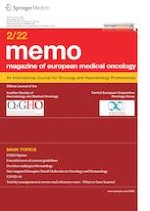06.05.2022 | original report
High mortality in patients with active malignancy and severe COVID-19
Results from an Austrian multicenter registry during the first period of the COVID-19 pandemic
Erschienen in: memo - Magazine of European Medical Oncology | Ausgabe 2/2022
Einloggen, um Zugang zu erhaltenSummary
Background
Various registries of patients with cancer and coronavirus disease 2019 (COVID-19) emerged over the last few months and patients with cancer are reported to be at increased risk for severe outcome of COVID-19. Yet, many studies lack a direct control group and include patients with different baseline parameters. Here we report data for patients with active malignancy who were hospitalized for severe COVID-19 and a control group hospitalized with severe COVID-19, but not diagnosed with ongoing malignant disease. Moreover, we incorporate the prognostic 4C Mortality Score which estimates in-hospital mortality for COVID-19 patients.
Methods
In all, 245 patients hospitalized with severe COVID-19 between March 2020 and March 2021 were included in the analysis. Among those, 89 patients were diagnosed with active malignancy. Primary endpoint was COVID-19-associated mortality.
Results
COVID-19-associated mortality was significantly higher in cancer patients than in the control group (46.1 vs. 27.6%, odds ratio [OR] 2.56, p < 0.001). In multivariable analysis, diagnosis of active malignancy (OR 4.59) and poor ECOG status ≥ 3 (OR 6.56) were the strongest predictors of COVID-19-related death. The prognostic 4C Mortality Score correctly predicted mortality in the control group (occurred: 27.6%, vs. estimated: 27.3%, p > 0.999), but significantly underestimated COVID-19-related mortality in cancer patients (occurred: 46.1% vs. estimated: 32.2%, p = 0.003).
Conclusion
Active malignancy was associated with high mortality in patients with severe COVID-19 during the first period of the COVID-19 pandemic. The mortality rate was underestimated by the 4C Mortality Score.
Anzeige
